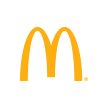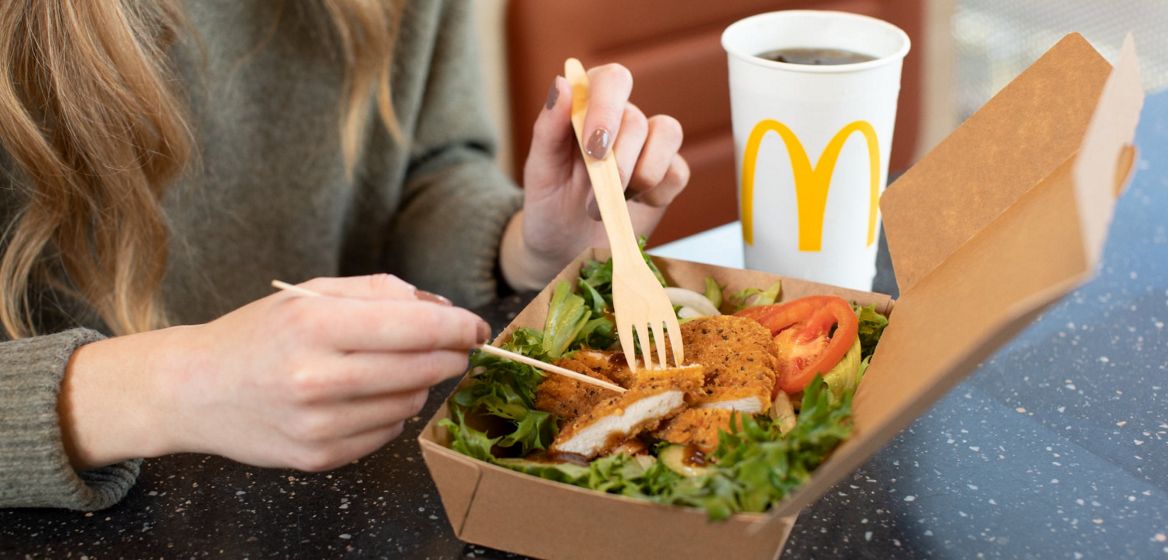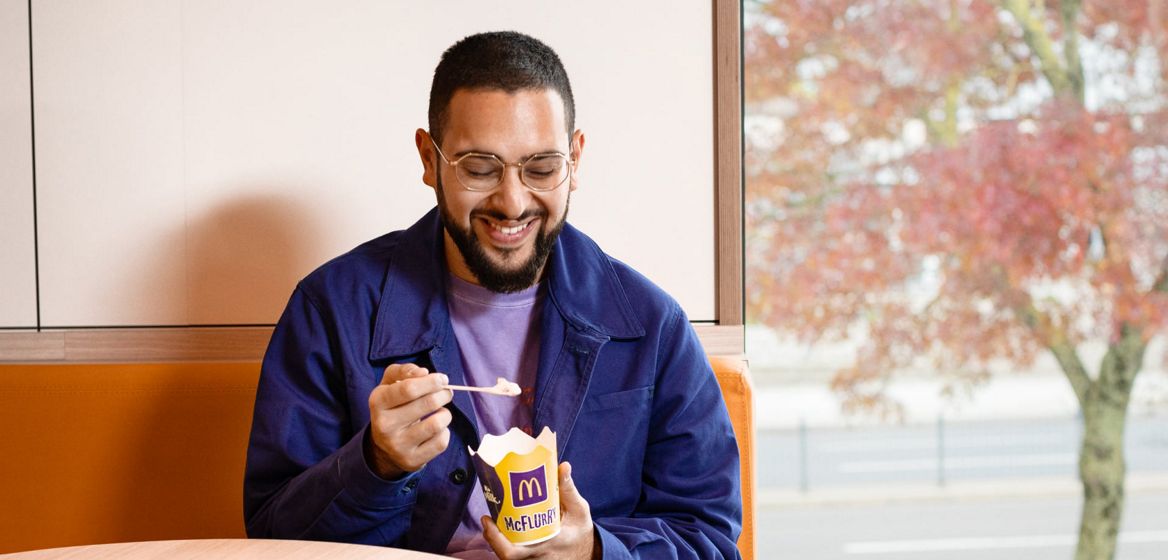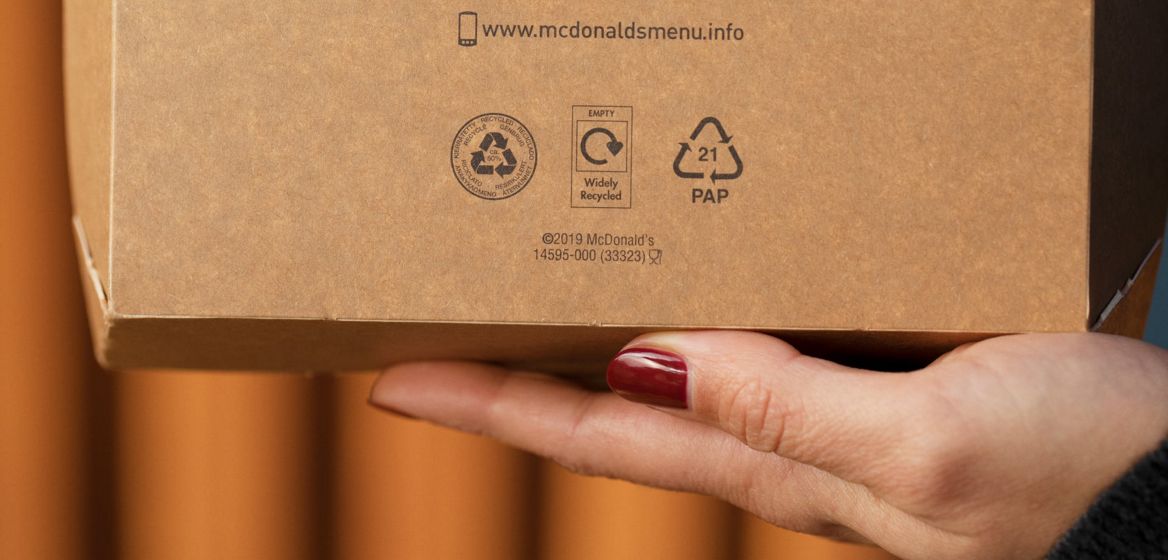Packaging, Toys & Waste
We are working to accelerate solutions that help reduce waste while also transitioning to more sustainable packaging and toy materials.
Our packaging, toys and waste strategies are designed to help keep communities clean, help protect the planet for future generations and support the Company’s long-term business resilience. To achieve this, we’re evolving our packaging – redesigning some of our most iconic products to eliminate unnecessary packaging, identifying alternative materials and increasing opportunities for recovery.
Our Recent Progress
- By the end of 2023, we were approximately 86.7% of the way toward our goal of sourcing 100% of our primary guest packaging from renewable, recycled or certified materials.1, 2
- From 2018–2023, we reduced virgin fossil fuel-based plastic in Happy Meal toys by 63.7%.3
- In 2023, more than 88.3% of restaurants in markets with advanced infrastructure4 offered guests the opportunity to recycle and/or compost packaging items.
See our latest Purpose & Impact Report on the Goal Performance & Reporting page for our most recent goals, performance and actions.
Our Strategy
We’re committed to taking steps to help reduce waste and advance a circular economy. For example, we’re investing in strategies and working collaboratively with other stakeholders to help address systemic challenges related to recycling infrastructure, demand for recycled materials and development of new packaging and toy materials. We continue to evaluate and consider the role reusables can play in our restaurants around the world, alongside other circularity solutions and in compliance with applicable laws regarding reusable packaging.
By the end of 2025, we are aiming to meet four goals that advance our strategy. See our packaging, toys and waste goals and performance for our latest progress. There is more on our progress and actions in our latest Purpose & Impact Report (PDF – 6 MB).
Focus on Circular Economy
We understand the significant opportunity and responsibility there is to use materials and natural resources efficiently – from sourcing and design to end-of-life management of everything we use to serve our customers. We focus on a circular economy approach and seek to apply it to areas across our business, from guest packaging to restaurant design. One of our goals is to implement global and local solutions across our business to drive the reduction, recycling, recovery or reuse of guest packaging and to help create demand for recycled materials by the end of 2025.
We look to implement various tools to help drive progress on our global commitments and advance a more circular economy. This includes improving material recycling and repurposing rates for guest packaging – making it easier for customers to recycle it where infrastructure exists and reducing the amount of guest packaging-related waste coming from our restaurants.
Examples of actions we are taking to help achieve our ambitions include:
- Helping enable the recycling of guest packaging in restaurants – with solutions tailored to specific markets and suited to local needs and infrastructure – such as providing additional recycling bins in some restaurants where infrastructure exists.
- Collaborating with waste management companies, suppliers and other brands to help remove some of the barriers to guest packaging recycling or composting.
- Working with suppliers to optimize our packaging for recycling, where feasible.
- Using on-packaging labeling where feasible and consistent with applicable law, to help make recycling and disposal choices easier for guests.
- Helping create demand for recycled materials by sourcing more recycled materials for use in our packaging.
- Utilizing transport logistics companies to help us efficiently collect recyclables from restaurants.
Increasing Demand for Recycled Materials
One of our goals is to source 100% of our primary guest packaging from renewable, recycled or certified materials by the end of 2025. Because food-grade recycled material is in limited supply, we are focusing on sourcing recycled materials for paper bags, napkins and cup carriers first. Depending on location, recycled materials are also currently used in some hot beverage cups, cup sleeves, cartons, fry boxes, plastic beverage and dessert cups, as well as select plastic lids. We are collaborating with industry organizations and other brands to help leverage scale and create demand for food-safe, post-consumer recycled materials.
We aim to expand our use of recycled materials, consistent with our goal of implementing global and local solutions across our business to help create demand for recycled materials by the end of 2025. This includes packaging, toys and design materials for restaurants and facilities.
Collaborating to Increase Scale of Circularity Solutions
Promoting circularity is not a challenge we can tackle alone. To help drive the scale and impact of a circular economy approach to guest packaging and waste, we are engaging with external and internal stakeholders such as peer companies, nongovernmental organizations (NGOs), policymakers, academics, Franchisees, suppliers, customers and restaurant crew. We also share learnings with policymakers from the Company’s experience of its restaurants and supply chain to help foster evidence-based policymaking.
Examples of such engagement include:
- The Company is a principal member of ReSource: Plastic, World Wildlife Fund’s (WWF) platform for translating large-scale corporate commitments into measurable progress on plastic waste reduction. Through an innovative measurement tool, ReSource is bringing transparent reporting and collective action to the forefront of corporate strategy to help companies maximize and multiply their potential for impact.
- McDonald’s USA joined the NextGen Consortium, which aims to address the global issue of single-use food packaging waste. The Consortium has representation from several brands and plays a leading role in increasing recycling access for paper and plastic single-use foodservice packaging through collaborations with various industry bodies, NGOs and communities.
- The Company is a member of the Bioplastic Feedstock Alliance (BFA), a WWF-led consortium of companies, NGOs and academia advancing thought leadership on responsibly sourced bio-based plastic and the role the material can play in supporting circular systems.
- McDonald’s Australia engages with the Australian Packaging Covenant Organization (APCO), a not-for-profit focused on developing a circular, more sustainable packaging economy in Australia. As an APCO Brand Owner Member, McDonald’s submits an annual report highlighting progress against the APCO Packaging Sustainability Framework, a consistent and transparent tool for assessing and tracking packaging sustainability across organizations. Over the years, we have contributed to APCO’s industry discussions, including topics such as limiting certain chemicals in packaging and reviews of how to approach single-use packaging. We have also joined the APCO fiber-based committee working group, providing technical feedback on all fiber-based packaging recyclability.
- McDonald’s USA is a member of the Foodservice Packaging Institute’s (FPI) Paper Recovery Alliance (PRA) and Plastics Recovery Group (PRG). Alongside other brands and packaging suppliers, McDonald’s USA participates in these groups to help increase paper and plastic foodservice packaging recycling or composting. Through the FPI, we work with communities, recycling facilities, composters and end markets to help expand recovery options for these valuable materials.
- McDonald’s USA actively participates with the Association of Plastic Recyclers (APR), an international nonprofit focused on improving recycling for plastics, by developing tools to support design guidance for recyclability and innovation challenges.
- In 2023, McDonald’s Canada joined the Canada Plastic Pact, which unites partners behind a vision of creating a circular economy.
- In 2023, McDonald’s USA formally joined The Recycling Partnership’s Polypropylene Recycling Coalition in the U.S. We have committed to a direct contribution of $3 million from 2023–2025 toward the goals of the Coalition to increase recycling of polypropylene.
- The Company engages in the multi-stakeholder group 4evergreen to share learnings and evidence on fiber recycling and reusable packaging. Using the 4evergreen platform, we share expertise to develop tools, solutions and guidelines to jointly reach improved recycling rates for fiber-based packaging in Europe.
Focus on Materials
We have a goal to source 100% of our primary guest packaging from renewable, recycled or certified materials by the end of 2025. We’re working with suppliers to optimize our packaging for recycling, where feasible, helping them innovate in support of this goal and creating opportunities for behavior change to help advance the reduction, reuse or recycling of guest packaging.
Sourcing Materials Responsibly
We aim to source materials responsibly and to help suppliers advance new technologies. We collaborate with our suppliers and other innovators to help them deliver solutions against the Company’s stated goals.
We have established commodity requirements for both fiber and plastic packaging, and maintain a supplier management process that includes sustainability evaluations.
Find out more about our approach to Responsible Sourcing and how we are working to protect Nature, Forests & Water.
Transitioning Away From Virgin Fossil Fuel-Based Plastics
The Company’s strategy for transitioning away from virgin fossil fuel-based plastics focuses on:
- Sourcing 100% of our primary guest packaging1, 2 from renewable, recycled or certified materials by the end of 2025.
- Drastically reducing plastics in Happy Meal toys around the globe and transitioning to more sustainable materials by the end of 2025.3
- Reducing small plastic primary guest packaging that is hard to recycle and unnecessary for safety or functionality, such as straws, plastic bags and cutlery.
- Exploring innovations that help increase plastics recyclability, increase demand for recycled plastics and promote plastic alternatives such as molded fiber, starch-based cups and mineral coatings for fiber.
Packaging Stewardship for Safety
Hygiene, safety and functionality are critical aspects of our guest packaging, and we strive to ensure they are balanced with long-term sustainability. To uphold this, we follow a product stewardship process that includes robust evaluation and testing of chemicals used in our guest packaging.
We take steps to help ensure the Company’s guest packaging materials comply with all applicable laws. We are committed to ensuring all primary guest packaging is free from added fluorinated compounds by the end of 2025.1
Visit our Food Safety page to learn more about our commitment to food safety.
Focus on Waste
We believe the greatest opportunity to address guest packaging-related waste is to advance safe, proven solutions – including reduction and recycling – where existing infrastructure and innovation can be effectively scaled across industries and communities.
In markets with an advanced waste infrastructure4 that is widely accessible and robust, we offer guests the opportunity to sort packaging for recycling in restaurants. In areas where recycling infrastructure is underdeveloped and less robust, we aim to help advance the development of recycling systems through advocacy and related strategies.
We also aim to eliminate any unnecessary packaging where we can. For example, we try to help reduce guest packaging-related waste volumes associated with items such as straws, napkins and cutlery by only providing such items upon request in certain locations.
Reducing Litter
We are taking action to advance litter reduction initiatives in certain locations, such as through engagement with government, recycling companies and consumers. Additionally, we’re collaborating with companies and nonprofit organizations to support development and expansion of recycling.
Addressing Food Waste
McDonald’s has developed guidelines to reduce supply chain food waste using a hierarchy adapted from the U.S. Environmental Protection Agency’s (EPA) Food Recovery Hierarchy. Our approach is supported by our Global Food Disposition Policy to help reduce food waste in restaurants and supply chain facilities, encouraging markets to develop solutions and approaches based on local needs and priorities.
Key Definitions
- Certified sources: Suppliers of primary fiber-based packaging and toys to the McDonald’s System that comply with the Forest Management and Chain of Custody certification requirements set out by one of the following schemes: Forest Stewardship Council® (FSC®); Programme for the Endorsement of Forest Certification (PEFC) or PEFC-endorsed national systems, including, for example, Sustainable Forestry Initiative (SFI), CSA Group (Canada) and Cerflor (Brazil).
- Perfluorinated (fluorinated) compounds: Known to be historically persistent in the environment. McDonald’s commits to not intentionally adding fluorinated compounds through our processes, but fluorinated compounds present in the local environment make it difficult to remove all traces of fluorine from packaging.
- Primary guest packaging: Disposable products used to package guest food on premises at McDonald’s restaurants that is given to customers in all order channels, including containers, cups, clamshells, wraps, foodservice bags, napkins, folding cartons, salad bowls, lids, straws, napkins and cup carriers, and Happy Meal book and toy packaging.
- Recycled sources: Material that has been reprocessed from recovered (reclaimed) material by means of a manufacturing process and made into a final product or into a component for incorporation into a product. Recycled material applies to plastics and fiber.
- Recovered (reclaimed) material: Material that would have otherwise been disposed of as waste or used for energy recovery but has instead been collected and recovered (reclaimed) as a material input, in lieu of new primary material, for a recycling or a manufacturing process. Source: ISO 14021:2016.
- Renewable material: Material that is composed of biomass from a living source and that can be continually replenished. For McDonald’s definitions, renewable only refers to plastics, not fiber. Source: ISO 14021:2016, for plastic, ASTM 6866 or ISO 16620-2.
- Renewable sources: Proportion, by mass, of renewable material in a product or packaging. Claims must be documented, verifiable and related to the finished product. Source: New Plastics Economy Global Commitment Ellen MacArthur Foundation 2018; this is adapted from ISO 14201:2016.
- Virgin fossil fuel-based plastics/Conventional/Traditional plastic: Plastics made from virgin fossil fuel feedstock.
Footnotes
1 Packaging. Scope: Inclusive of all markets for our fiber-based packaging and Happy Meal book and toy packaging. For our plastic-based packaging, all markets are included except for Israel, Latin America and Turkey. Renewable sources refers to material that is composed of biomass from a living source and that can be continually replenished. Renewable applies to plastics only, not fiber. Source: ISO 14021:2016 for plastic, ASTM 6866 or ISO 16620-2. Fiber-based packaging made from 100% recycled sources must be third-party verified, unless certified under a Chain of Custody Forest Management standard. McDonald’s requires all wood fiber sourced from Argentina, Cambodia, China, Indonesia, Laos, Malaysia, Russia and Vietnam to be Forest Stewardship Council® (FSC®) certified or FSC® controlled wood sources with full chain of custody certification. Perfluorinated compounds are known to be historically persistent in the environment. McDonald’s commits to not intentionally adding fluorinated compounds through our processes, but fluorinated compounds present in the local environment make it difficult to remove all traces of fluorine from packaging. Please refer to our Nature, Forests & Water web page for additional definitions. Exclusions: Primary fiber-based packaging in food packaged off-site of McDonald’s restaurants, tray liners and limited locally sourced items.
2 Non-structural components of packaging vary based on the packaging but may include adhesives, inks, overprint varnishes, retention agents or binders, processing aids, impact modifiers, minerals used non-structurally and nucleating and clarifying agents. We continue to monitor industry standards on these components and opportunities to work toward making any part of our packaging, including non-structural components, more sustainable.
3 Toys. Scope: Inclusive of all toys. Fiber-based toys or fiber components in the toys: 100% certified fiber required. All other materials: McDonald’s ambition is to reduce the use of virgin fossil fuel-based plastics, offer sustainable toys by the end of 2025 and not manufacture electronics and batteries in Happy Meal toys globally. For bio- and plant-based plastics to be considered sustainable for McDonald’s, a minimum of 60% of plastic weight is required to come from recycled or renewable content or a combination of recycled and renewable content, though in many practical applications we anticipate that percentage will be much higher. The remaining 40% may be conventional fossil fuel-based material. These thresholds were developed in conjunction with input from NGOs, external manufacturing partners and scientists, and based on an assessment of sustainable toy and packaging industry leaders so that our targets reflected current sustainable engineering capabilities to maintain safety and functionality. Our efforts will result in an approximate 90% reduction in virgin fossil fuel-based plastic use against a 2018 baseline. Fiber-based packaging made from 100% recycled sources must be third-party verified, unless certified under a Chain of Custody Forest Management standard. Source: ISO 14021:2016. McDonald’s requires all wood fiber sourced from Argentina, Cambodia, China, Indonesia, Laos, Malaysia, Russia and Vietnam to be Forest Stewardship Council® (FSC®) certified or FSC® controlled wood sources with full chain of custody certification. The thresholds described above do not include the presence of adhesives, glues, inks, paints and coatings.
4 Markets with advanced infrastructure: Mature waste and recycling infrastructure at a national level that has (1) a recycling infrastructure network across the entire market, (2) multiple materials being recycled within this national infrastructure network, (3) existing legislation on recycling and (4) high customer awareness of waste and recycling. At the end of 2023, that included 21 markets where McDonald’s operates.






